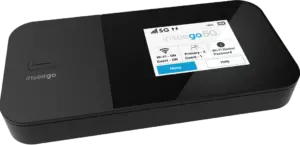The Best RV Internet Options for 2026
Tips for staying connected when you’re traveling around the country.
Dec 16, 2025 | Share
Technology
-
Best for weekend tripsT-Mobile Inseego MiFi X PRO 5G
- Price: $264.00
- Generous data plan
- 5G connection
-
Best for RV ParksALFA Network WiFi-Camp Pro 3
- Price: $209.99†
- Dual-band Wi-Fi 5
- High-gain omni-directional antenna
-
Best for internet enthusiastsStarlink Roam Unlimited
- Price: $165/mo.*
- Nationwide coverage
- In-motion use option
An RV gives you a lot of freedom and flexibility. It’s a low-cost way to travel. It’s a great way to visit friends and family, plus you always have your stuff with you. While you can get basic utilities at a full hookup, it’s not always easy finding reliable Wi-Fi out on the road. Here’s a look at some of the best internet solutions for RV owners.
Best internet options for RVs
| Product | Price | Features | |
|---|---|---|---|
| Best for weekend trips | T-Mobile Inseego MiFi X PRO 5G | $264.00 |
|
| Best for RV Parks | ALFA Network WiFi-Camp Pro 3 | $209.99† |
|
| Best for internet enthusiasts | Starlink Roam Unlimited | $165/mo.* |
|
Data effective 12/16/2025. Offers and availability may vary by location and are subject to change.
* Plus hardware, shipping & handling fees, and tax. Fully refundable. Depending on location, some orders may take 6 months or more to fulfill.
How to pick the right internet solution for your RV
There’s not just one thing you can do with an RV, which means there’s not just one best option for RV internet. Depending on the frequency of your trips, how long you stay in one spot, your destination, and the way you use the internet, there are several solutions that can help you stay connected to the rest of the world.
Mobile hotspots—If you’re often on the road and want a reliable internet connection you can take with you, a dedicated mobile hotspot is a flexible and affordable choice. Much like cell phones, hotspots require their own SIM card and data plan, so there is a long-term cost to plan for.
Wi-Fi extender—If your usual destination is an RV park or other sites with public Wi-Fi, you may not need to invest in a device with its own data plan. Wi-Fi extenders are designed to help you pick up weak or distant Wi-Fi signals, allowing you to get better reception when connecting to these public networks.
Portable 4G internet service—For those who think of their RV as a second home (or even their first), you probably want a reliable internet connection that gives you all the comforts of home. Portable 4G LTE plans can deliver reliable broadband speeds while not requiring a fixed address like home 4G plans.
Mobile satellite internet—Starlink recently released Starlink Roam Unlimited, its new portable satellite system that replaces previous programs like Starlink Portable and Starlink RV. With a satellite connection, Roam Unlimited offers a reliable connection, even in the most remote parts of the U.S. and offers higher speeds than 4G connections. It also allows in-motion use of the system, though this feature requires very expensive equipment.
Other helpful resources for RV internet

Pro tip:
Download speeds on 4G networks depend both on which network you use and where you’re trying to use it. Because of this variation mobile internet providers often advertise “4G speeds” without giving actual numbers. 4G connections have average speeds of 28–35 Mbps, though this can be lower in more remote areas.1
Best for weekend trips—T-Mobile Inseego 5G MiFi M2000
Price: $264.00
- Wireless connection: 5G (mmWave, C-band, sub–6GHz), 4G LTE
- Wi-Fi 6
- USB-C Port
- Support for up to 32 Wi-Fi enabled devices
If you like to get out of town on the weekends to see new places, you’re going to need a simple and flexible internet solution. Mobile hotspots work much like a phone, connecting wirelessly to a provider’s cellular network. The hotspot then broadcasts a local Wi-Fi network you can use on your computers, tablets, and other devices just as you would at home.
The T-Mobile Inseego MiFi X PRO 5G has a lot of features that can make your weekend trips easier to manage. It features a 5G connection, but can also make use of 4G networks as a backup. The MiFi X PRO 5G also uses Wi-Fi 6. This allows you to connect loads of devices without your network slowing.
The MiFi X PRO 5G exclusively uses the T-Mobile network, which can be limiting in areas where other providers have better coverage. Fortunately, you can also find hotspots that use other networks—or even allow you to choose your preferred network for your data plan.
 Pros:
Pros:
- 5G Compatibility
- Multiple device support
 Cons:
Cons:
- Only T-Mobile network
- Limited 5G availability
Data as of 6/24/2025. Offers and availability may vary by location and are subject to change.
Best mobile hotspots
| Product | Price | Network | Max devices | Order online |
|---|---|---|---|---|
| T-Mobile Inseego MiFi X PRO 5G | $264.00 | T-Mobile | 32 | View on T-Mobile |
| TCL LInkzone 5G UW | $299.99 | Verizon | 32 | View on Verizon |
| NETGEAR Nighthawk M7 Pro | $449.99 | AT&T | 64 | View on AT&T |
| GlocalMe G4 Pro 4G LTE Mobile Hotspot Router | $169.99 | Any | 10 | View on Amazon |
Data as of 6/24/2025. Offers and availability may vary by location and are subject to change.
Best for RV parks—ALFA WiFi-Camp Pro 3
Price: $209.99*
- Extends WiFi hotspots Internet access
- Dual-band Wi-Fi 5
- Easy setup
- High-gain omni-directional antenna
Although not all sites with full hookups offer public Wi-Fi as they do with other utilities like water, sewer, and electricity, it’s becoming pretty easy to find at big campgrounds like KOA. Plus, fast food chains, libraries, and many other locations offer free Wi-Fi you can access.
The hard part about relying on public Wi-Fi is getting a strong signal. Wi-Fi extenders allow you to boost your wireless range to connect to Wi-Fi even if you didn’t get a prime spot next to the transmitter.
The ALFA Network WiFi-Camp Pro 3 is a system to to boost and share a Wi-Fi signal from a public Wi-Fi hotspot to your devices, which might not otherwise be able to connect to that signal.
It’s worth noting that this type of extender is different from the Wi-Fi extenders you use at home to boost the range of your router. Instead, the WiFi-Camp Pro 3 allows your computer to pick up Wi-Fi signals from farther away.
 Pros:
Pros:
- Easy setup
- Dual-band WiFi-5
 Cons:
Cons:
- Requires Wi-Fi connection
Data effective 12/16/2025. Offers and availability may vary by location and are subject to change.
Best Wi-Fi extenders
| Product | Price | Wi-Fi version | Rebroadcasts | 4G capable | Order online |
|---|---|---|---|---|---|
| ALFA WiFi-Camp Pro 3 | $224.99 | Wi-Fi 5 (ac) | Yes | No | View on Amazon |
| Winegard – 80800 ConnecT 2.0 | $249.00 | Wi-Fi 4 (n) | Yes | Yes | View on Amazon |
| ALFA Network WiFi CampPro 2v2 | $333.98 | Wi-Fi 4 (n) | Yes | No | View on Amazon |
Data effective 12/08/2025. Offers and availability may vary by location and are subject to change.
Best for internet enthusiasts—Starlink Roam Unlimited
Price: $165/mo.*
- Speeds up to 300Mbps
- Nationwide Coverage
- In-motion use option
- 1 TB data cap
Starlink Roam Unlimited was launched back in early 2023 as a portable satellite internet service. At the time, it wasn’t a great deal, as it was both slower and more expensive than standard Starlink internet, plus you needed special $2,500 Flat High Performance Starlink kit if you wanted to make use of its in-motion feature. However, with the release of the Starlink Roam 50GB, which works with in-motion use and is small enough to practically transport, as well as cheaper mobile plans, Roam is a much more viable option.
The Roam Unlimited plan is a big jump in price from the 50GB plan, but does away with the data cap. Although the monthly cost is expensive for an internet plan, it’s actually on par with many mobile 4G plans while offering much higher speeds. The biggest barrier for new customers is the upfront equipment cost. The basic equipment for Starlink Roam has a one-time cost of $499, which, while much more affordable than the $2,500 it cost for the old Flat High Performance equipment, is still a big upfront cost.
Roam Unlimited isn’t the best choice for everyone, but for a very specific use case, it can be a game-changer. If you need fast, reliable internet while you’re driving across the country, no other provider can match the experience that Roam Unlimited offers. If, however, a fast connection on the highway isn’t worth investing several thousand dollars, there are much cheaper options that can get you by with less.
 Pros:
Pros:
- Widest possible coverage
- High data cap
- In-motion use option
 Cons:
Cons:
- High upfront equipment costs
- Delays in equipment delivery
Data as of 12/16/2025. Offers and availability may vary by location and are subject to change.
*Plus hardware, shipping & handling fees, and tax. Fully refundable. Depending on location, some orders may take 6 months or more to fulfill.
Best portable 4G LTE / satellite internet
| Plan | Price | Networks | Data cap | Order online |
|---|---|---|---|---|
| Starlink Roam Unlimited | $165/mo. (plus onetime $499.00 equipment fee)* |
| Unlimited | View plan |
| UbiFi | $99.00/mo. |
| Unlimited | View plan |
| Ladybug Wireless | $124.99–$219.99/mo. |
| 300–750 GB | View plan |
Data as of 12/03/2025. Offers and availability may vary by location and are subject to change.
*Plus hardware, shipping & handling fees, and tax. Fully refundable. Depending on location, some orders may take 6 months or more to fulfill.
Internet considerations for RV owners
Getting reliable wireless internet in an RV depends on two things: data caps and coverage areas. You can also avoid paying for a data plan altogether if you’re willing to limit yourself to using just public Wi-Fi.
Which option is worth the cost depends on how much use you get out of your internet plan. You don’t want to pay a monthly bill for a data plan you never use, but you also don’t want to limit where you can go just to stick close to an internet connection.
Connections with a 4G data plan
Using a device with a 4G data plan is extremely flexible, allowing you to connect to the internet anywhere with cell service. Many 4G devices also give you the option to choose the wireless carrier for your data plan. AT&T, Verizon, and T-Mobile all have nationwide networks, though their coverage can be more spotty in remote areas.
If you spend a lot of time visiting national parks or rural areas, you might want to consult major providers’ websites to see which one best covers the areas you visit. In more urban areas, all three providers have near 100% coverage, so it’s usually safe to choose the most affordable option.2
Dealing with data caps
The biggest difference in cost between wireless data plans comes down to data. Although you can save money by choosing a plan with less data, it’s surprisingly easy to burn through an entire month’s worth of data in just a few days if you streama lot of video. We suggest going with an unlimited data plan if you have the option. While more expensive, they’re much cheaper than dealing with overage fees.
If you head out in your RV only on weekends, it’s possible to get by on a cheaper plan with less data. If you choose a plan with limited data, you should know how much data you typically use. You definitely don’t save any money paying for overage charges.
Campground Wi-Fi
Many campgrounds, including big chains like KOA, offer public Wi-Fi. Connecting to campground Wi-Fi instead of using your own connection can help you save mobile or hotspot data. It can also give you faster speeds and a more stable connection, especially if you’re using a Wi-Fi extender.
If you don’t have an extender, make the most of your Wi-Fi connection by picking a spot near the transmitter that doesn’t have any major obstructions like trees that block line of sight.
Campgrounds aren’t the only places you can get public Wi-Fi. These offer connections too:
- Coffee shops
- Diners
- Fast-food restaurants
- National Park Visitor Centers
- Truck stops
In many of these places, the Wi-Fi is designed to cover only the people inside the building, so you either need to park really close or have a good Wi-Fi extender to pick up the signal. For more ideas on connecting to public Wi-Fi, check out our guide on how to find Wi-Fi hotspots.
Our verdict
For RV internet, we suggest going with the cheapest option that meets your needs. For most people, a hotspot like the T-Mobile Inseego MiFi X PRO 5G is probably the best option, as hotspots are relatively affordable and work in a lot of locations. If you spend most of your time in locations that offer Wi-Fi, you might be able to get by with just a good Wi-Fi extender, while full-time RVers might need a more reliable option like a portable 4G internet plan or Starlink’s Roam Unlimited.
Internet for RVs FAQ
Can you get internet in an RV?
What is the best RV internet?
What do full-time RVers do for internet?
Sources
-
- Francesco Rizzato, Opensignal, “Mobile Network Experience Report,” July 2021. Accessed February 28, 2022.
- Francesco Rizzato, Opensignal, “Mobile Network Experience Report,” January 2022. Accessed February 28, 2022.
Disclaimers
Product prices and availability are accurate as of the date/time indicated and are subject to change. Any price and availability information displayed on Amazon.com at the time of purchase will apply to the purchase of this product. HighSpeedInternet.com utilizes paid Amazon links.
CERTAIN CONTENT THAT APPEARS ON THIS SITE COMES FROM AMAZON. THIS CONTENT IS PROVIDED ‘AS IS’ AND IS SUBJECT TO CHANGE OR REMOVAL AT ANY TIME.
Author - Peter Christiansen
Peter Christiansen writes about telecom policy, communications infrastructure, satellite internet, and rural connectivity for HighSpeedInternet.com. Peter holds a PhD in communication from the University of Utah and has been working in tech for over 15 years as a computer programmer, game developer, filmmaker, and writer. His writing has been praised by outlets like Wired, Digital Humanities Now, and the New Statesman.
Editor - Rebecca Lee Armstrong
Rebecca Lee Armstrong has more than six years of experience writing about tech and the internet, with a specialty in hands-on testing. She started writing tech product and service reviews while finishing her BFA in creative writing at the University of Evansville and has found her niche writing about home networking, routers, and internet access at HighSpeedInternet.com. Her work has also been featured on Top Ten Reviews, MacSources, Windows Central, Android Central, Best Company, TechnoFAQ, and iMore.







